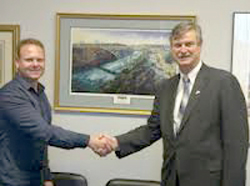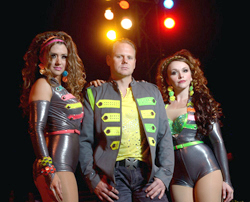Was Dyster Really Against Wallenda?
It was New York State Sen. George Maziarz who first proposed the idea of having the world's premier high wire artist, Nik Wallenda, cross Niagara Falls back in 2010.
Wallenda crossed the falls on June 15, 2012.
While Maziarz, later joined by Assemblyman John Ceretto, pushed the idea to the brink of completion, Mayor Paul Dyster was hell-bent on making himself the proverbial wet blanket for what was destined to be a world event.
Don't simply take it at our word that Dyster was opposed to Wallenda before, during and after the event.
On May 3, 2012, it was reported in the Niagara Gazette "that Dyster was opposed to the Wallenda walk from the outset. The Mayor, a staunch preservationist, is a firm advocate of Frederick Law Olmsted, the landscape architect whose 1880's plan [was] to preserve the beauty of the falls and surrounding parkland."
Instead of assuming a positive role, Niagara Falls Mayor Paul A. Dyster has been the voice of carping criticism, throwing darts at Nik Wallenda's high wire walk from the start.
Don Glynn, for the Niagara Gazette (June 17, 2011) wrote the "Flying Wallenda wire walk over the Niagara Gorge moved a step closer to reality Friday with the measure moving into the Assembly for consideration. Earlier, the bill sponsored by State Sen. George D. Maziarz, R-Newfane, passed the Senate, 62-0... That comes as a surprise to Niagara Falls Mayor Paul Dyster... who reportedly (was) never informed of the plan... Dyster said the city was not consulted before the bill was submitted to the Legislature."
Nevertheless, around the world, the press reported positive voices about the event, except for one consistent voice of antagonism.
On June 23, 2011, CKTB News reported that "Mayor Paul Dyster [said] he does worry about the repercussions of a high wire act over the Falls" and that "while Wallenda is a trained professional, he may encourage amateur stunters to attempt the feat, attempts he says will almost certainly end badly."
Also, according to CKTB News, "Dyster says respect must also be paid to the falls themselves. He doesn't want a 'sideshow over there' that he worries would take away from the falls' elegance and beauty. Dyster's stance doesn't line up with that of his Canadian counterpart [who supports the proposed walk."
The New York Post also reported Dyster being worried "that the event could be perceived as a 'sideshow' to the falls."
The Los Angeles Times called Dyster a "skeptic."
Again and again, the sole voice of negativity, Mayor Dyster found one thing after another to dampen the planned event.
He attempted to raise the specter of lawsuits over the alleged, unjust treatment of Wallenda's competitor daredevils.
On Oct. 28, 2011, Dyster told the Buffalo News that the one concern he had [about the event] was that, because Wallenda was the only tightrope walker offered this opportunity, that "you just want to be careful there's not a conflict of interest here."
Another of Dyster's concerns was that there might be too many wire walkers. "If this occurs often, it cheapens the real attraction," Dyster told the News on Feb. 19, 2012.
Running out of negatives, Dyster turned what should be a positive into a negative, by protesting that Niagara Falls would get "too many people" coming to witness the event.
"If we don't have rooms to sell to people, then the benefit is less. To us, to do it off of peak helps us," said Dyster to WIVB News.'
As the walk drew closer, Dyster attempted to bring out the big guns by raising the specter of death. Emphasizing the number of fatalities incurred by people either intentionally or accidentally falling over the falls, Dyster told the Buffalo News "I think the story line is man versus Mother Nature."
"If Mother Nature wins, maybe, in a way, that heightens the mystery of the falls," Dyster noted, but quickly added, "I'm not suggesting I'm rooting against him."
Dyster also expressed concern that the event would be a detriment to the legacy of Frederick Law Olmsted who designed the original Niagara Falls Reservation. He alleged that allowing the wire walk to proceed would alter the park to one that could become highly commercialized, "a Niagara Falls State Park which Olmsted would barely recognize."
The Mayor further demonstrated his displeasure for all things Wallenda by not showing up for any of the press events.
As Don Glynn wrote in the Niagara Gazette on May 3, 2012, "it shouldn't have come as any surprise that Mayor Paul A. Dyster was missing from VIPs at the [Wallenda walk] press session. It is common knowledge that Dyster was opposed to the Wallenda walk from the outset. The mayor, a staunch preservationist, is a firm advocate of Frederick Law Olmsted, the landscape architect whose 1880's plan was to preserve the beauty of the falls and surrounding parklands."
Dyster claims to be a believer in Frederick Law Olmsted's vision and that he was against the walk because it would degrade and defile the pristine nature of the falls.
He apparently, however, failed to take into account the acres of paid parking; the flags; the banners; the statuary; the souvenir buildings; the restaurants; and the ribbons of asphalt and concrete that deface almost every acre of Niagara Falls State Park.

